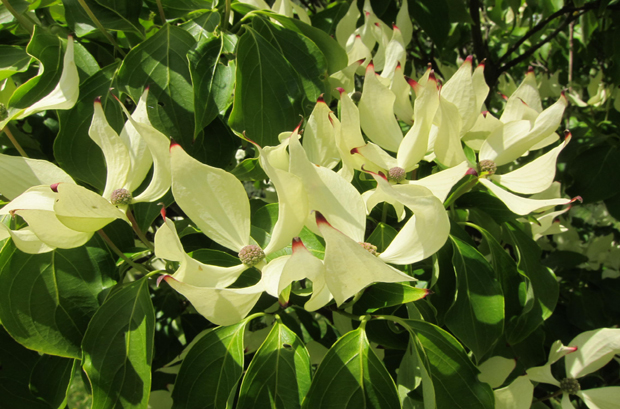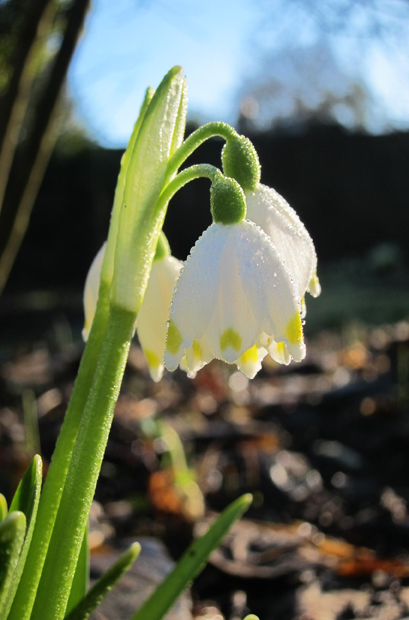When I was at college learning plant identification, one thing I did that I found very useful was to find out what the plant names actually meant. I found it helped me understand the plant a little better, and to use its attributes as a way to remember its name. It also translates across to other plants as once you know what the name means, you find yourself going ‘ahh…of course!’
(ABOVE: Daphne bohlua: Daphne – Greek name for the bay or laurel tree, named after the nymph who was transformed into the tree by the gods to save her from the persuit of Apollo, but also may be derived from the Indo-European root for ‘odour’; bohlua – Pronounced bo-LOO-a, is derived from bhulu swa, the name of the plant in the Nepalese (the plant orginates from the Himlayas))
The botanical naming of plants we are familiar with today was instigated by a Carl Linnaeus, back in the 1700s. This was a time of the great plant hunters and the beginning of a time when vast numbers of plants were being introduced to England.
Linnaeus standardised the naming system of plants and animals using a Latin binomial system that consisted of Genus followed by Species and as a result, he became known as the Father of Taxonomy.
(ABOVE: Cornus kousa: Cornus – from the Latin cornu, meaning hard (as in the wood); kousa – is the Japanese name for the tree (where the tree originates from))
It sure improved on the pre-existing system where plants were named (and names changed) at will. For example, the same wild rose could be named Rosa sylvestris inodora seu canina and also as Rosa sylvestris alba cum rubore, folio glabr. We don’t need mouthfuls like that anymore as a result of Linnaeus’s hard work, dedication and determination!
Today, in botany, we now have varieties and hybrids to add to his binomial system.
(ABOVE: Leucojum vernum: Leuco – signifies white, as in the flower colour; vernum – ‘of the Spring’, so essentially telling us when the plant flowers)
The naming of plants most commonly uses Latin, and sometimes Greek as its root (no pun intended!). Plant names will normally be derived from either
- the person who discovered or introduced it e.g. Tradescantia – from the Tradescant family
- the place it was discovered or introduced from e.g. Virginiana – Virginia, USA, or
- a descriptive part of the plant e.g. sanguinea – blood red (actually French derived!)
although you also find mythology, native names and the such used.
(ABOVE: Fritillaria melaegris: Fritillaria – from the Latin Fritillus meaning dicebox, signifying the spots on the petals; melaegris – also linking to the spots on the plant, and is the same name for the spotted guinea fowl)
Some examples of great descriptive botanical names!
delicio ‘sus, -a, -um = Delicious!
explodens = Bursting suddenly, exploding!
verruco ‘sus, -a, -um = Warty!
muco ‘sus, -a, -um = Slimy!
Some names are very obvious in their translation rather like the great examples above e.g.
defor ‘mis, -is, -e =Deformed
citriodo ‘rus, -a, -um = Smells like citrus
palmifol ‘ius, -a, -um = Palm shaped leaves
bulbifor ‘mis, -is, -e =Yup, you guessed it! Formed like a bulb!…see, you are on fire!
Some names are quite helpful in understanding the cycle of the plant e.g.
autumna ‘lis, -is, -e = Pertaining to Autumn
an ‘nuus, -a, -um = Annual
persis ‘tens = Persistent!
Some are telling you where they were found e.g.
virginia ‘nus, -a, -um = Virginian
sco ‘ticus, -a, -um = Scottish
taiwanen ‘sis, -is, -e = I’ll let you work that one out!
And some tell you who found them or where named in honour of e.g.
jeffersonia = The US president and botanical fanatic.
linnaea ‘nus, -a, -um = you get the picture!
And when you get more knowledgeable about plant names, then you can move on to names like the following….
Buxus = box, therefore buxifo ‘lius, -a, -um is box like leaf (folius meaning foliage!)
Hedera = Ivy, therefore hederifo ‘lius is ivy-leaved!
Gosh, you could really get nerdy playing this game!
(ABOVE: Embothrium coccineum: Embothrium – From the Greek for in bothrion, ‘a little pit’, an allusion to the possition of their anthers; coccineum – meaning scarlet)
Coming up soon, Ness’s Top Ten plants for Winter and Spring, and I will provide the translation for you!…….watch this space!




